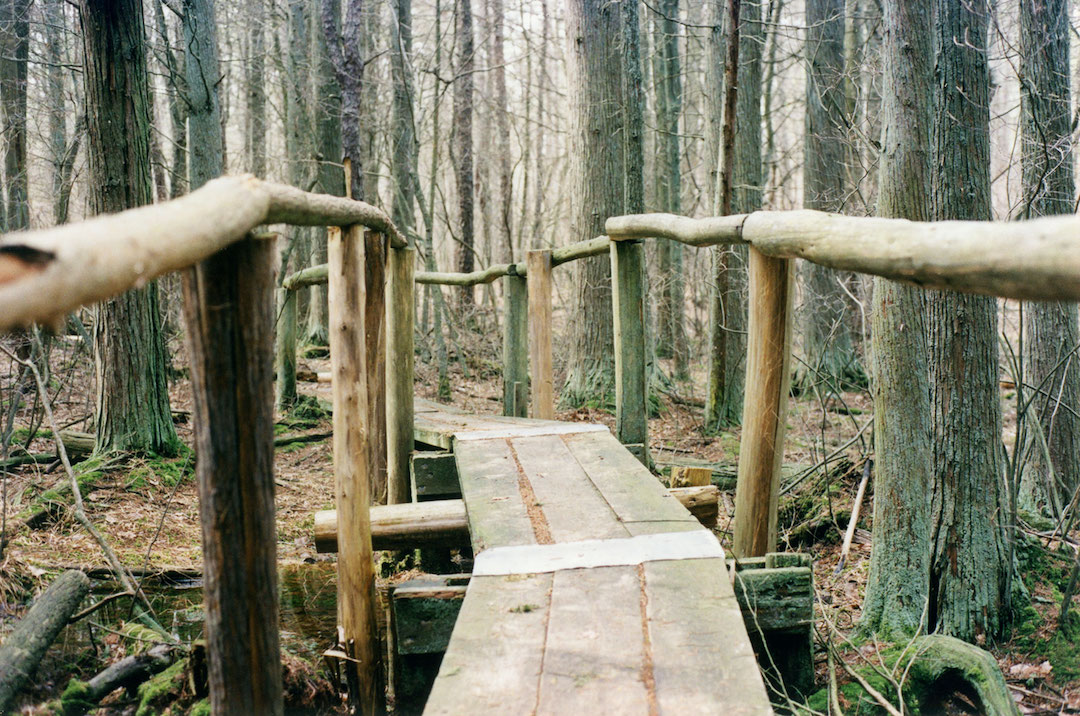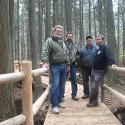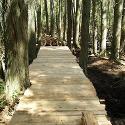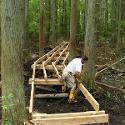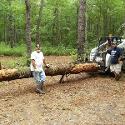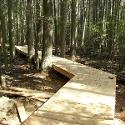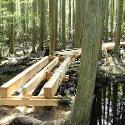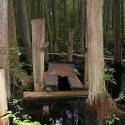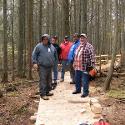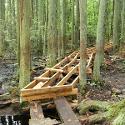The Cedar Bog Bridge
By Caroline Linton and Sarah Galzerano
What is the Cedar Bog Bridge?
For many students, faculty, and administrators, Stockton University is a home away from home. Of course, it is first an institution of higher education; but it is also a place where small communities thrive and share, at times, a measure of comfort and solace. This can be seen in the long-lasting friendships that students make and in the professional relationships forged among students and professors. It is found in the memories of the many, many activities that students cram into the four short years of their attendance—memories that they carry for the rest of their lives. At least in part, this community derives from locations around campus that each generation of Stockton students has “discovered” and claimed as their own.
One such location lies down a nondescript walking path to the west of parking lot 7. Perhaps your curiosity (or your adventurous spirit) guided you down that path; perhaps it was that newfound friend who dragged you there, on a whim, during midterms. A five minute walk transported you into another world, a Narnia of sorts. Suddenly, you smell marshy, clean air, see flowing, clear water, and then step on to a well-crafted, quaint wooden bridge. If you do not know this place, take a moment out of your busy day, throw on some good walking shoes, don appropriate gear, and experience Stockton’s cedar bog bridge. You will not regret it.
Details of the origin of the trail and bridge remain hazy. An article published in 1988 by ARGO contributor Paul Van Orden dates the “first” bridge to some time around 1978, before Stockton Action Volunteers for the Environment (S.A.V.E.) was founded. Undoubtedly, this first bridge was frequented by the early students of Stockton. The cedar bog, after all, is a wondrous place on campus. It is also a very humid place, and unattended bridges soon rot. After several years, the first bridge had, indeed, decayed and become overgrown. In 1989, S.A.V.E. took action to clear the trail and rebuild the bridge. Again, the cedar bog was easily accessible and much frequented by the Stockton community. Again, cohorts of students “discovered” the bridge and made it their own. Those who visited could stand among the tall, mast-like Atlantic White Cedars and watch as they gently swayed in the wind; they could sit with legs dangling in Cedick Run, feeling its smooth water rill beneath the bridge. At least once in the 1980s students married in a hand-fast ceremony held just past the bridge in a small clearing next to the largest cedar in the area, Old Spiral.
Move the bar left to right to see a photograph of “Big Spiral” taken around 2006 turn into the photograph of the stump of “Big Spiral” alone in the woods. This photograph taken in February 2015.
Over the years, however, the trail once again became overgrown and the bridge, year after year, decayed further. During wet periods it became all but impassable. Sometime late in the first decade of the 2000s, a terrible deed was done. Someone (or some people) cut down the tall and incredibly beautiful cedar that stood just across the west side of the bridge, the Big Spiral.
Stephen Brown, a Stockton employee in the carpenter shop, helped build the newest iteration of the bridge in 2010. When interviewed about the bog at this time, Brown noted that the felled Big Spiral had been down for some time before the rebuilding began; “the outside of the tree stump was pretty rotted,” indicating that the cedar had been vandalized well before the rebuilding efforts. The 1989 bridge had become dangerously decayed and the surrounding bog area was litter-strewn. There was even a large, smashed television at the foot of the bridge.
Such dreadful conditions at this beautiful spot were a call to action for Plant Management. During the summer of 2010 a team of craftsmen, including Brown, began cleaning the area and planning a new span. The new bridge, which took a couple of months to build, was laid over the remnants of the 1989 bridge. Large support beams were constructed out of Big Spiral, which the team had hauled from the forest and had milled at Ed McCay’s mill in Nesco. The rest of the bridge was constructed from rough cut cedar and cedar posts. In the fall of 2010, students once again began to “discover” the Cedar bog and bridge. It has had many names: Ewok Village, the Smoking Bridge, the Enchanted Forest, or just the bog.
We considered concluding this essay with a grand statement about nature and place and community, but that seemed too erudite and abstract for such a living, well-loved place. If you have visited the Cedar Bog once, and been attentive during that visit, you will know the power of the spot. We leave this essay unfinished, hoping that the Stockton community, past and present, will remember their time spent at the Cedar bog bridge and create personal, suitable endings.
Photos of the Cedar Bog Bridge
Editors Note:
It has been ten years since the Cedar Bog Bridge was rebuilt in the summer of 2010. Even though built of Atlantic White Cedar, which is quite impervious to rot, ten years in a humid cedar bog has necessitated repairs. In these photos you can see Stockton’s carpenter shop back at work, renovating the bridge. Soon, it will be ready for a visit.
Cedar Bog in Snow
